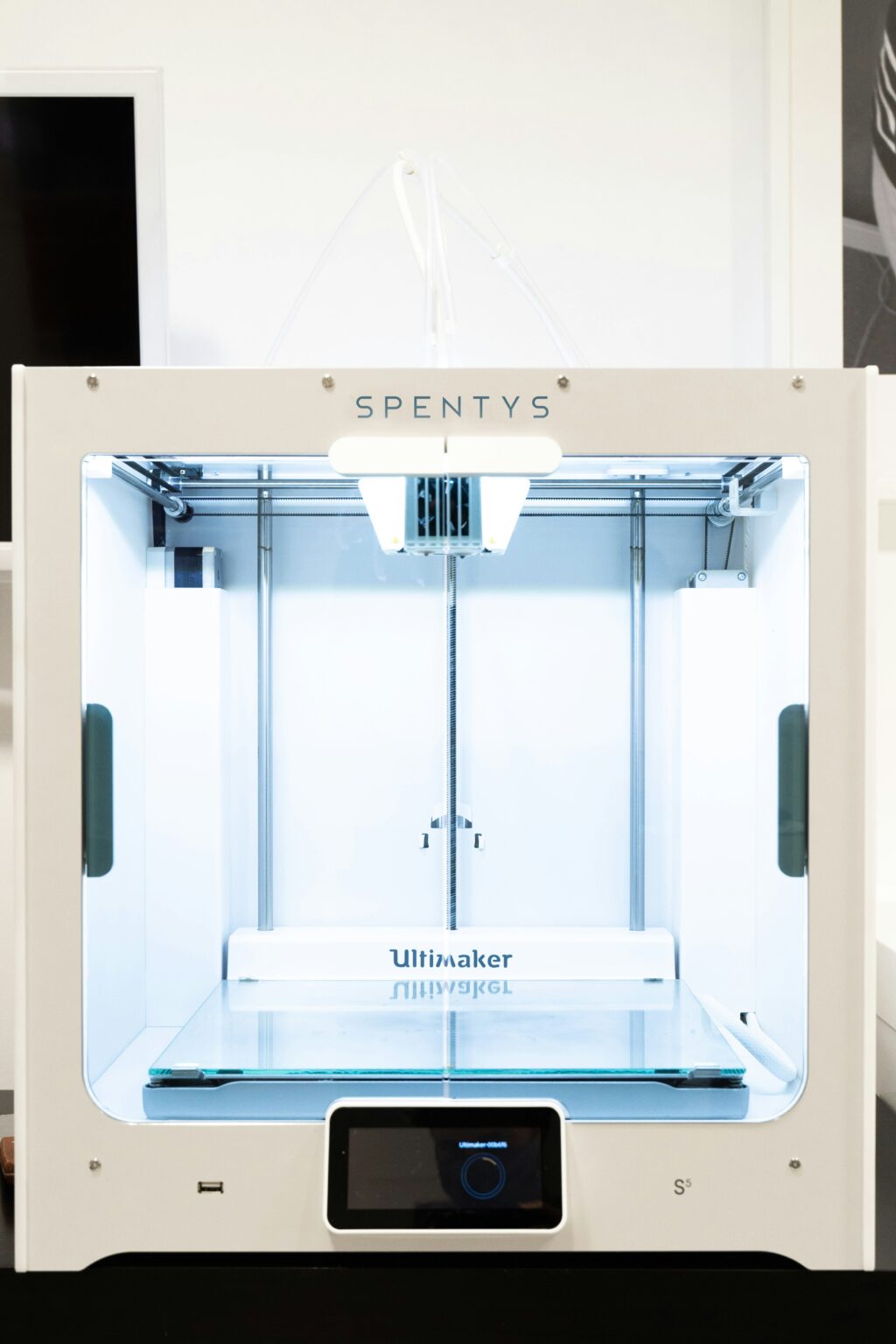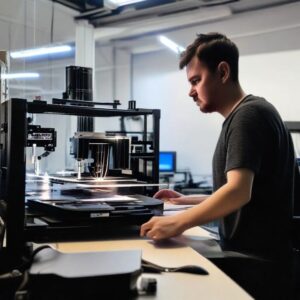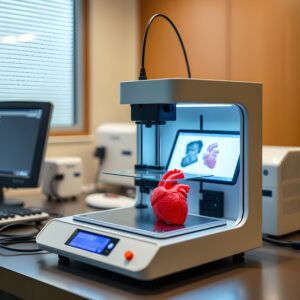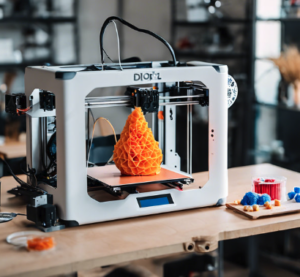
A Transformational Shift in 3D Printing
The world of 3D printing is experiencing rapid transformations. Once seen as a niche technology, 3D printing has now become an integral part of several industries, from healthcare and aerospace to construction and defense. According to leading experts in the field, such as Bradley Rothenberg, CEO of nTop, the next decade will witness even more profound changes in how 3D printing is utilized. These advancements will not only make the technology more accessible and efficient but will also tackle critical issues like sustainability and supply chain resilience.
AI and Machine Learning in 3D Printing
At the heart of these developments lies artificial intelligence (AI). AI’s role in 3D printing is rapidly expanding, with its application spanning from optimizing design processes to enhancing production efficiency. As AI models become more sophisticated, they are expected to accelerate design iterations, reduce material waste, and predict manufacturing outcomes with greater precision.
Rothenberg, for example, emphasizes the role of AI in computational design, where algorithms help create optimal designs for complex parts. By automating tedious tasks such as model generation and data analysis, AI frees up engineers to focus on innovation and problem-solving.
The Growing Role of Sustainability in 3D Printing
One of the most pressing concerns in modern manufacturing is sustainability. As industries face increasing pressure to reduce their carbon footprints, 3D printing is emerging as a key solution. Unlike traditional manufacturing processes, which can produce large amounts of waste, 3D printing is more material-efficient. The additive nature of 3D printing—where materials are deposited layer by layer—minimizes waste by using only the material needed for the part itself. Moreover, the ability to use recycled or eco-friendly materials in the printing process further reduces the environmental impact.
Several leaders in the industry, such as Joseph Crabtree, CEO of AMT (Additive Manufacturing Technologies), highlight that the future of 3D printing lies in its ability to create sustainable, circular production ecosystems.
The focus is shifting from purely technological advancements to more application-centric innovations. In industries like construction, for instance, 3D printing is being used to produce sustainable building materials that can help rebuild communities in disaster-stricken areas.
By using recycled concrete or biodegradable materials, 3D printing can play a crucial role in creating environmentally friendly and affordable housing solutions.
Expert Insights: Shaping the Future of 3D Printing
To better understand the direction of 3D printing, we spoke with several experts in the field who provided insights into how these trends are evolving.
Joseph Crabtree, CEO of AMT: Automation and Sustainability
Crabtree, who heads AMT, explains that automation will be one of the driving forces behind the industry’s growth in the coming years. Automation in 3D printing will span the entire production process, from design to post-processing. The focus will shift from individual technological improvements to an integrated system where AI-powered software can design, print, and even finish parts with minimal human intervention.
The push toward sustainability will also be paramount. According to Crabtree, the materials used in 3D printing will increasingly be sourced from recycled and renewable sources. For example, recycled plastics and metals are already being used to create parts for everything from automotive components to medical devices. As 3D printing materials become more sustainable, it will help reduce the industry’s overall environmental footprint.
Bradley Rothenberg, CEO of nTop: Computational Design and AI’s Impact
Rothenberg’s insights into the role of AI in 3D printing are particularly eye-opening. He discusses how computational design allows for more complex and optimized designs that traditional methods cannot achieve. This is particularly valuable in industries like aerospace, where weight reduction and structural integrity are critical. Through nTop’s software, engineers can now design 3D-printed parts that are not only lighter but also stronger and more cost-effective than their traditionally manufactured counterparts.
Rothenberg also discusses the challenges that lie ahead, particularly in data transfer and software standardization. Currently, one of the biggest obstacles facing the widespread adoption of 3D printing is the lack of universal standards for transferring and interpreting 3D printing data. By solving this issue, experts believe the technology will become much more accessible to industries and companies that are currently hesitant about integrating it into their manufacturing processes.
Kristin Mulherin, Director of Additive Manufacturing Technology at Hubbell: Expanding Beyond Traditional Industries
Kristin Mulherin, who serves as the Director of Additive Manufacturing Technology at Hubbell, shares a forward-looking perspective on the widespread adoption of 3D printing across industries. Mulherin notes that while aerospace, medical, and automotive sectors have been the main adopters of 3D printing, industries like robotics, electronics, and even food production are beginning to explore its potential.
For example, the food industry is experimenting with 3D-printed food items, such as chocolates and pasta, while some companies are looking into the possibility of printing entire meals using plant-based ingredients. This shift towards more creative and experimental applications demonstrates the versatility of 3D printing and its potential to revolutionize industries previously considered outside the scope of additive manufacturing.
Real-World Applications of 3D Printing in 2024
The scope of 3D printing applications has expanded far beyond rapid prototyping. Today, it is a pivotal tool in full-scale production across various industries. Let’s take a closer look at some real-world examples of 3D printing’s impact in 2024.
Aerospace: Lightweight, Complex Components
In the aerospace sector, 3D printing has enabled the production of lightweight, complex components that were previously impossible or prohibitively expensive to manufacture. By using 3D printing, companies like Airbus and Boeing are able to create parts with intricate geometries that reduce weight and improve fuel efficiency. This trend is expected to grow, as additive manufacturing allows for the creation of custom parts tailored to specific needs, whether for military aircraft, commercial planes, or space exploration.
Healthcare: Personalized Medical Devices and Implants
The healthcare industry has seen one of the most significant impacts of 3D printing, particularly in the creation of personalized medical devices and implants. 3D printing allows for the production of custom prosthetics, hearing aids, and even implants that are designed to fit the unique anatomy of each patient. This customizability is critical for improving patient outcomes and reducing recovery times.
One of the most notable advancements in medical 3D printing is the development of bio-printed tissues and organs. While still in its early stages, this technology holds the promise of creating functional tissues that can be used for transplants, reducing the need for organ donors, and eliminating the risk of transplant rejection.
Construction: 3D-Printed Buildings and Structures
In the construction industry, 3D printing is being explored to build affordable, sustainable housing. Companies like ICON are already printing homes using concrete-based materials, which are both durable and cost-effective. The ability to print entire buildings, including walls and roofs, on-site can dramatically reduce labor costs and construction time. Moreover, using 3D printing in construction is precious in disaster relief, where it can quickly provide temporary shelters or permanent housing solutions.
AI and 3D Printing: Unlocking New Possibilities
AI’s role in 3D printing extends beyond optimizing designs. One of the most promising applications of AI in additive manufacturing is its ability to support “inverse design.” This approach allows AI algorithms to analyze a problem from an outcome-oriented perspective and then work backward to find the most efficient design solution. For example, in the automotive and aerospace industries, AI can quickly calculate optimal shapes for parts that need to balance strength, weight, and other factors.
This process can be exponentially more efficient than traditional design methods, as AI models use data from previous designs to predict optimal material usage and structural configurations. AI’s predictive capabilities also extend to 3D printing simulations, where it can predict printing outcomes before a part is even printed. This ability can save manufacturers valuable time and reduce the likelihood of costly mistakes.
A notable example of AI’s impact on manufacturing is found in the work done by the retail and robotics company Ocado. Using AI-driven 3D printing software from nTop, Ocado was able to reduce the number of iterations needed to design its fulfillment robots, a task that previously took hundreds of iterations. The new approach allowed the company to accelerate its design process, ultimately improving its efficiency and reducing costs.
AI’s value doesn’t end with design optimization. It is also making strides in the area of predictive maintenance. In the context of 3D printing, AI can analyze sensor data from 3D printers to predict when parts are likely to fail or require maintenance. This capability can minimize downtime and increase the overall efficiency of manufacturing processes.
Sustainability Challenges and Solutions
While 3D printing offers significant environmental benefits, such as reducing waste and enabling the use of recycled materials, it is not without its challenges. One major issue is the energy consumption associated with 3D printing technologies, particularly for large-scale production. To address this, companies are exploring ways to make 3D printing more energy-efficient. Innovations in materials science are also being explored, with researchers looking for new, more sustainable materials that can be used in 3D printing without compromising the performance of the final product.
One such example is the use of bio-based materials, which are derived from renewable resources such as plant fibers and natural resins. These materials have the potential to replace petroleum-based plastics, which are commonly used in traditional 3D printing processes. Researchers are also exploring the potential for creating closed-loop systems in 3D printing, where waste materials can be fed back into the printing process to create new products.
The demand for more sustainable solutions is not just coming from environmental groups but also from consumers and companies that are increasingly prioritizing corporate social responsibility. For instance, some companies are now using 3D printing to create products from biodegradable plastics that break down more quickly than traditional materials. This trend is particularly important in industries such as fashion and consumer goods, where the environmental impact of production processes is often a key concern.
Looking Toward the Future of 3D Printing in 2024 and Beyond
As 3D printing continues to evolve, the technology’s reach will only continue to expand. Experts believe that by 2024, 3D printing will be an integral part of many more industries, thanks to its ability to create custom, on-demand parts that would be difficult or impossible to produce through traditional manufacturing methods.
The construction industry is a prime example of a sector where 3D printing is poised to make a huge impact. The ability to print entire buildings, including walls, roofs, and other structural elements, has the potential to revolutionize construction. In disaster-stricken areas, 3D printing could be used to quickly erect shelters and homes, helping to address the ongoing housing crises in many parts of the world . 3D Printing Industry
In healthcare, 3D printing’s potential is particularly exciting. As the technology matures, it could be used to create personalized medical implants, prosthetics, and even organs. This would not only improve the quality of life for patients but also reduce the cost of healthcare by making custom medical devices more affordable.
Even in sectors like fashion, 3D printing is beginning to make its mark. Designers are experimenting with 3D-printed fabrics and garments, creating complex, customizable designs that were once impossible to achieve using traditional methods. This is another example of how 3D printing is not only transforming established industries but also creating entirely new ones.
.
A Transformative Force for Industries
As we move further into 2024, the impact of 3D printing on industries across the globe will continue to be profound. AI, sustainability, and cross-sector collaboration are all playing significant roles in shaping the future of 3D printing. With continued advancements in materials, software, and applications, 3D printing will no longer be viewed as a futuristic technology but as an essential tool for modern manufacturing.
From personalized healthcare solutions to sustainable housing, and from AI-powered design tools to new materials that reduce waste, the possibilities for 3D printing in the coming years are endless. As industry leaders like Rothenberg and Crabtree suggest, the future of 3D printing is not just about improving technology—it’s about using that technology to solve some of the world’s most pressing problems. And as the technology continues to evolve, it will unlock new opportunities for innovation across industries and society as a whole.





